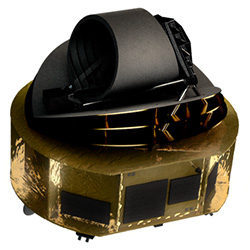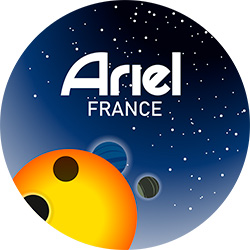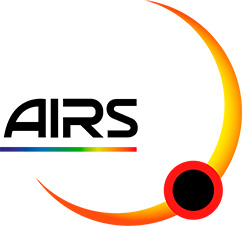
Artist’s rendering of the Ariel Spacecraft
© Ariel/Science Office
TOWARDS THE REALIZATION OF ARIEL, TO DECIPHER THE ATMOSPHERES OF EXOPLANETS
The Ariel mission of the European Space Agency (ESA) moved from the study phase to the realization phase on November 12, 2020, following which an industrial contractor will be selected to build the satellite. IAP is a major actor of the project as co-Principal Investigator of the mission. Ariel will study the composition of exoplanets, how they are formed and how they evolve, by monitoring a diverse sample of about 1000 planetary atmospheres, at both visible and infrared wavelengths simultaneously.
On Thursday November 12, 2020, at the end of the study phases, the Science Program Committee of the European Space Agency (ESA) gave the go-ahead for the realization of the Ariel mission (Atmospheric Remote-sensing Infrared Exoplanet Large-survey). Ariel aims to address one of the key themes of ESA's “Cosmic Vision” 2015-2025 program, the current long-term planning cycle of scientific space missions: what are the conditions for the formation of planets and the emergence of life? The launch is scheduled for 2029 by an Ariane 6 rocket from Kourou, French Guiana. During the planned four-year mission, Ariel will probe the atmospheres of about 1,000 planets during transits or eclipses, that is when a planet passes in front of the star around which it is in orbit (transit) or behind the star (eclipse). During a transit, the planet's atmosphere is traversed by the star's light and reveals valuable information about its composition. The difference between the global light emitted by the star and the planet just before the eclipse, and the star alone during the eclipse, also makes it possible to measure the energy emitted by the day side of the planet (the one lit by the star), thus giving information on the composition of the planet. This is the first time that a space mission will be devoted to the systematic study of the atmospheres of exoplanets.
The planets that will be observed by Ariel will have diameters ranging from those of the gas giants, that is between 4 times (for Uranus and Neptune) and 11 times (for Jupiter) the diameter of the Earth, to the super-Earths, the planets with intermediate mass between those of the giants and the Earth. These planets will be chosen so that their host stars describe a range of spectral types (characterizing their luminosity and temperature). Ariel will focus on “hot” planets (temperatures above 400 kelvin, or 120°C) for which one can observe the so-called “tropospheric” low atmospheric layers, in which a strong mixing by convection leads to a homogeneous chemical composition. Ariel will measure the composition and structure of the atmospheres of these planets by detecting molecules such as water, methane, carbon monoxide or dioxide, as well as ammonia or hydrogen cyanide; these components can be detected in the form of aerosols or clouds. By observing some planets over long periods of time, Ariel will be able to provide meteorological data, characterized by temporal variations in the properties of the atmospheres of these planets. Finally, by taking into account the temperature of the atmosphere and its chemical composition, the researchers will be able to put constraints on the internal composition of each planet.
Ariel consists of a space telescope with a primary mirror of elliptical shape (1.10 x 0.73 meter), in order to simultaneously optimize the collecting surface and the bulk. At the focus of the telescope, two instruments will be used to analyze the planetary atmospheres. The infrared spectrometer Ariel InfraRed Spectrometer (AIRS) will cover wavelength ranges between 1.95 and 7.8 microns with a spectral resolution of R=30-200. The Fine Guidance system (FGS) instrument will observe in parallel the range 0.5-1.2 microns with photometric channels, and the range 1.2-1.95 microns with a low resolution spectrograph. The instrumental payload will be cooled to 55 Kelvin (-218°C) thanks to heat shields. The detectors of the AIRS instrument will be cooled to an even lower operating temperature of 35 kelvin (-238°C).
The mission is coordinated by Giovanna Tinetti, as Principal Investigator, and the United Kingdom Space Agency, which is leading a consortium of more than 60 institutes in 15 European countries. The two main partners are France and Italy, with significant contributions from Austria, Belgium, the Czech Republic, Denmark, Germany, Hungary, Ireland, the Netherlands, Poland, Portugal, Spain, Sweden and the Czech Republic. The United States of America is associated with the project through the supply of elements of the FGS instrument, via NASA.
The Centre National d'Etudes Spatiales (CNES) is responsible for the production of the AIRS instrument (i.e. its design, realization and delivery), in partnership with the IAP, the Commissariat à l'Energie Atomique (CEA), the Institut d'Astrophysique Spatiale (IAS), and the Laboratoire d'Etudes Spatiales et d'Instrumentation en Astrophysique (LESIA) of the Observatoire de Paris. CNES is the prime contractor for the construction of AIRS, and provides essential expertise in all the space engineering activities of the instrument. The work is carried out under the supervision of the Institut de Recherche sur les lois Fondamentales de l'Univers (IRFU) of CEA, with technical contributions from IAS and LESIA. The French laboratories mentioned are also involved in the preparation and analysis of the data that will be collected by Ariel, as well as in the scientific exploitation of the mission.
This new stage of the project is a turning point for the Institut d'Astrophysique de Paris (IAP), as co-Principal Investigator of the mission. IAP's contributions started with pioneering studies as early as 2008, which contributed to the design of Ariel and then its adoption by ESA. The IAP team is composed of the researcher Jean-Philippe Beaulieu, French project leader, the researcher Pierre Drossart, who joined IAP in September 2020 (formerly at LESIA), the research engineer Andrea Moneti, the post-doctoral student Clément Ranc, and the PhD student Amélie Gressier. This team will focus on the development of algorithms to analyze the set of data that will be obtained by the AIRS and FGS instruments of Ariel, and correcting them for the systematic biases. The IAP team will also work on the production of mission scenarios (the list of stars to be observed and the frequency of repetition of their observation), and the scientific exploitation of the data (analysis and interpretation of the results).
Links
![]() ESA’s press release: “Ariel moves from blueprint to reality”
ESA’s press release: “Ariel moves from blueprint to reality”
![]() CNES’s press release: “Adoption par l’ESA de la mission Ariel dédiée à l’étude de l’atmosphère des exoplanètes”
CNES’s press release: “Adoption par l’ESA de la mission Ariel dédiée à l’étude de l’atmosphère des exoplanètes”
![]() IAP website’s highlight on the selection of Ariel by the European Space Agency in 2018: “The Ariel space mission selected by the European Space Agency”
IAP website’s highlight on the selection of Ariel by the European Space Agency in 2018: “The Ariel space mission selected by the European Space Agency”
Press
![]() Le Figaro’s article: “La mission Ariel sur l'atmosphère des exoplanètes est “adoptée” par l’ESA”
Le Figaro’s article: “La mission Ariel sur l'atmosphère des exoplanètes est “adoptée” par l’ESA”
![]() Sciences et Avenir’s article: “La mission Ariel sur l'atmosphère des exoplanètes est “adoptée” par l’ESA”
Sciences et Avenir’s article: “La mission Ariel sur l'atmosphère des exoplanètes est “adoptée” par l’ESA”
Writing and contacts
- Jean-Philippe Beaulieu
Institut d’astrophysique de Paris, CNRS, Sorbonne Université
beaulieu [at] iap [dot] fr
- Pierre Drossart
Institut d’astrophysique de Paris, CNRS, Sorbonne Université
drossart [at] iap [dot] fr
Web writing: Valérie de Lapparent
Layout: Jean Mouette
December 2020


